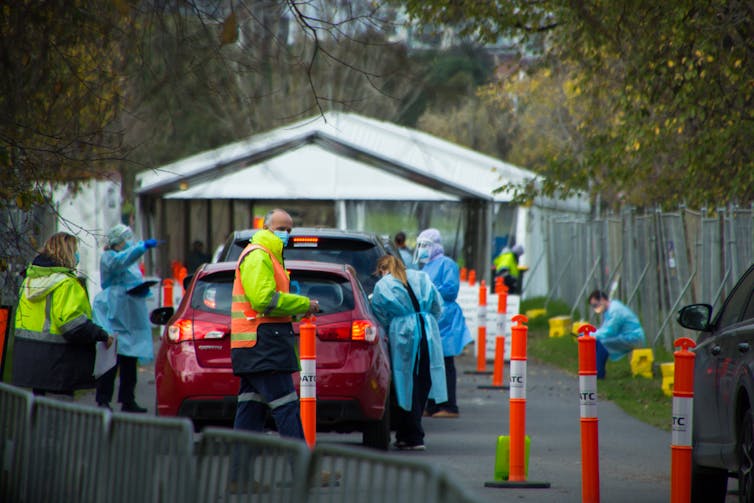Stephen Duckett, The University of Melbourne
For many people, the term “bulk-billed” refers to a GP visit they don’t have to pay for out-of-pocket. But another form of bulk-billing is in the news ahead of May’s federal budget – bulk-billing of pathology testing, such as blood tests.
This relates to the fees pathology companies receive from Medicare to perform out-of-hospital laboratory tests, the type your GP might order to help diagnose or monitor disease.
These pathology fees have been frozen for almost a quarter of a century. Is that fair? Obviously not, argues Australian Pathology, which represents private pathology laboratories.
It has recently launched its “Keep Pathology Bulk Billed” campaign. At the core is a request for about an extra $160 million a year for pathology companies. It argues this is needed to keep most out-of-hospital pathology tests free for the public.
But simple solutions put forward by vested interests involving more public funds are rarely in the public interest. Here’s how we might design a fairer pathology system, fit for the 21st century, that keeps tests free for the public.
Pathology is big business
Collecting specimens and analysing them is big business. Pathology providers received almost $3.25 billion for out-of-hospital tests in 2022-23 from Medicare rebates. Pathology testing is also conducted in public and private hospitals, but these are funded under a combination of different arrangements.
Almost all (more than 99 per cent) of out-of-hospital pathology services are bulk-billed. That’s a rate much higher than that for GP visits, which stood at about 80 per cent in the same period.
Pathology use is increasing faster than the population is growing. That’s partly because of more chronic disease in the population, and partly because new tests are becoming available.
Pathology provision is concentrated in a few hands, with a number of providers listed on the Australian Stock Exchange. Increases in pathology rebates, as Australian Pathology is calling for, would go straight to companies’ bottom lines, increasing shareholder value.

So, why are pathology companies calling for more funding now? Pathology companies’ profits burgeoned during the first years of the COVID pandemic, with the introduction of widespread PCR testing and the government funding that went with it.
But the industry was accused of profiting from “COVID-19 misery”, and the gravy train eventually ended. So pathology companies are now looking to replace that revenue, using the latest campaign to try to increase rebates.
Does the pathology industry have a point?
On the face of it, a 24-year freeze on pathology government rebates might seem unfair. But a look into the pathology world reveals an industry where there has been significant productivity growth.
An increased volume of standard tests, as we’ve seen in recent years, can lead to improved productivity. For instance, companies can work their testing equipment harder – running them for longer, loading them with more samples – lowering the cost per test. Improvements in equipment also allow tests to be done quicker, allowing increased economies of scale.
But a fee freeze is a lazy policy, an example of “set and forget”. While it does achieve some benefits for the taxpayer, it’s not optimal. That’s because it assumes all the productivity savings (from automation, digitisation and increased economies of scale) exactly offset any increased costs from inflation. This is never likely to be true. Given the current extent of automation and consolidation, this is probably leaving excess profits in the pockets of providers, and costing governments more than they need to pay.
More changes in pathology provision are yet to come. Advances in artificial intelligence are accelerating and automated reading of some pathology tests may reduce pathology costs further, yielding more profits for providers.
Future policies need to reflect changes in how much it costs to provide pathology services, details of which are thin on the ground.
What needs to happen?
The government should step back and ask whether a fees-for-pathology-service payment system, designed a century ago when pathology provision was literally a cottage industry, is still right in an era of extensive automation and ownership concentration. The answer is clearly no.
Reform should first dump the existing uncapped, fee-for-service payment system. Pathology is a big business and should be paid as such using tenders and contracts.

Pathology companies should be invited to tender to provide out-of-hospital pathology services in designated geographic areas. Two or more tenders could be approved to maintain competition between providers and keep options open for the end of the tender period. Pathology contracts should involve no out-of-pocket payments by consumers.
In-hospital pathology should not be covered by the same arrangements. Instead, private hospitals should make their own contractual arrangements for pathology provision, as they do now.
Public pathology services – run by state governments or their agencies such as Pathology Queensland – are also changing.
Consolidation of public pathology services in New South Wales yielded significant improvements in productivity. Victoria has started a less ambitious reform process, consolidating into three public providers rather than the single public provider model seen in NSW, Queensland and South Australia. This will also probably yield savings.
Public providers should be invited with private providers into the tender process to enhance competition.
What’s the take-home message?
The world of pathology provision is in flux, with more changes on the horizon, whether that’s related to technology or consolidation. In this environment, paying more to private providers under a payment system that has passed its use-by date is not good policy. That’s despite its simplistic attraction and advocacy from vested interests.
So, the next time you go to a pathology collection centre and see posters encouraging you to email your MP to “keep pathology bulk billed”, beware. The campaign is more about company profits than saving you money.
Stephen Duckett, Honorary Enterprise Professor, School of Population and Global Health, and Department of General Practice and Primary Care, The University of Melbourne
This article is republished from The Conversation under a Creative Commons license. Read the original article.
Do you think private medical companies deserve more public funds? Why not share your opinion in the comments section below?

